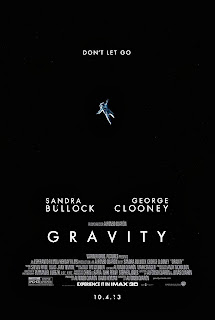When rumours started flying that Sandra
Bullock was starring in a sci-fi film that was gearing up to be one of the
event films of 2013, it seemed logical to assume that it was going to be a
big-budget adventure film with plenty of character clichés and genre
conventions. This is not an insult
against Bullock, it’s just that she has always suited mainstream popcorn fodder
and romantic comedies. However, the
rumours turn out to be true – this is the performance of a lifetime in a film
that could dominate critical and popular Top-Ten Sci-Fi lists for years to
come…
The film consists entirely of two
astronauts undertaking space walks whilst repairing a space station and
preparing to return to earth. Ryan Stone
(Bullock) is on her first job and is replacing Matt Kowalski (George Clooney)
who is on his final mission. As they are
making the final preparations for the returning to Earth, they hear that there
has been an accidental NORAD missile strike against Russia and that this has
begun a chain reaction that throws all manner of space debris in their
direction, which throws Stone out into deep space stranded on her own…
Gravity is essentially a two-person stage show
set entirely in deep space (one day I hope that an ambitious production team
translates it to the stage…). There is
little set-up and all of the action unfolds in and around the space stations
that are already in orbit. There are a
few voices that communicate from Earth, but ultimately it is just the two of
them up there, which makes this one of the most beautiful character studies
ever committed to film.
Firstly, the 3D work is incredible. Having shunned 3D presentations for the best
part of a decade, it is becoming undeniably impressive in certain releases and
has set the bar high for the future.
There is a moment late in the film where a single tear drop falls off of
Stone’s face and moves towards the camera as the focus drops away from the
inside of the spacecraft. It is a
remarkable sequence that uses the 3D technology to heighten the emotion of the
scene instead of feeling like the usual ‘spectacle’ that 3D designers try to
create.
Secondly, the performance from Bullock
is absolutely heartbreaking. Clooney
simply calls in his best Clooney impression…nothing special there. But I feel like I owe Sandra Bullock an
apology for pigeonholing her for the best part of my life – I had written her
off after Speed and The Net nearly 20 years ago. She is in almost every single shot, and is
having to combine honest, emotional terror with (onscreen) NASA professionalism
in a way that seems realistic yet intimate.
If anyone is skeptical about the choice of casting…trust me, it works.
It seems obvious to even mention it, but
the central metaphorical theme of a woman left to drift out in space is another
overt reflection of American (and global) cultural sexism. Imagine the same film with a male protagonist
and it simply wouldn’t inspire the same chilling empathy. There is a scene when Stone climbs out of her
spacesuit and floats into the fetal position in zero gravity, which is a clear
reference to Ripley in Alien, and forces the viewer to adopt a
maternal/paternal viewpoint as we reflect on the relief that she has finally got
temporary safety from the outside.
Again, trying to imagine a male character in a sci-fi curled into the
fetal position is ludicrous – they would never show such signs of weakness.
Revealing too much of the plot will
obviously ruin the movie, but seeing that everyone that is going to watch this
film knows that it is a disaster movie then it seems permissible to comment on
the genesis of the crisis: the pesky Russians…
There is a wonderful coincidence in the
timing of the release of this film: American supremacy (embodied onscreen in
NASA) is under threat as America in reality is so inefficient that the
government has recently had to shutdown. Ironic then that the crisis in this
film is seemingly traceable to Russian incompetence – a cold war hangover at
the core of the otherwise hyper modern narrative. 99% of the audience wouldn’t have batted an
eye-lid had the reference to Russia been replaced with America, yet still the
threat must come from abroad.

No comments:
Post a Comment